|
Go To | Photo Products Technical Information |
LabLine Training Index |
Training Series
Part One
Basic Color Theory
The 3M LabLine Training Series is a regular feature of the LabLine which will provide a primer on many subjects related to photofinishing technology, theory and application. The subject discussed in this and the Winter issue will be Color Theory. The study of light and its colors will be presented followed by a general knowledge quiz on the subject. The information in this and following features will furnish the reader with a ready reference on the subject and supply a source of information and materials to train new employees. Beginning with the spring issue, a multiple part series will be presented on Photographic Printing.
Light
Visual perception or seeing is totally dependent on the presence of light. White light or daylight balanced light, is composed of equal amounts of red, green and blue light. These three colors are called the primary colors. By combining equal amounts of two primary colors, three more colors can be formed. See figure below.
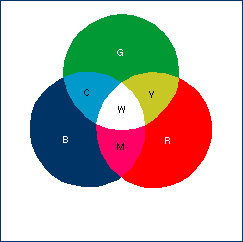
Equal amounts of red and green light, when combined, will form yellow light. Red and blue light combined will form magenta light. And green and blue light combine to form cyan light. Cyan, magenta and yellow are called secondary colors.
The Young-Helmholtz theory states that all human vision involves the sensations produced by red, green and blue light acting together. It also states that every color sensation is the result of the stimulation by these three colors in some definite proportion. Therefore, every color can be produced by adding together the correct proportions of red, green and blue light. Color photography uses this principle.
Photographic films and papers (color) are manufactured with three separate light sensitive layers of emulsion, one which is sensitive to red light, one to green light and one to blue light. Each of the layers, when exposed and processed, form a specific color dye. The dyes are the complementary color of corresponding light sensitive layers. In the red light sensitive layer, for example, a cyan dye is formed. Cyan is the complement or opposite of red. Cyan is everything red light is not; green and blue light.
Complements are two colors of light, a primary and a secondary, that when combined in equal amounts, form white light. Red and cyan are complements, green and magenta are complements, as well are blue and yellow complements. Remember:
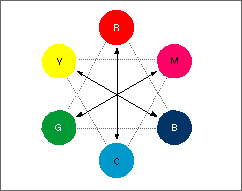
Red + Green + Blue = White Light
Red + Cyan (Green + Blue) = White Light
Green + Magenta (Red + Blue) = White Light
Blue + Yellow (Red + Green) = White Light
Therefore:
Red and Cyan are complements
Green and Magenta are complements
Blue and Yellow are complements.
Filters
A filter is any substance which will absorb light. When you see a green object, such as a leaf, the surface of the leaf absorbs the red and blue light. And the green light is reflected back to your eyes. If an object appears black, the object is absorbing all the light striking it and none is reflected back. Black is the absence of color. White objects absorb very little light, therefore, the red, green and blue portions of light are reflected back to your eyes to form white.
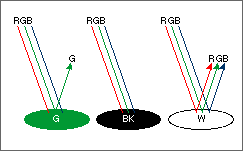
If an object absorbs equal amounts, but not all of the red, green and blue light, the object will look gray. All colors are formed by the reflection of specific proportions of red, green and blue light.
Photographic Filters
Photography also uses filters. However, in this case, the filters used are transparent. The colors seen in a negative or a print are made up of layers of transparent filters.
Transparent filters have specific properties. In general, transparent filters will pass their own color of light and block the complementary color. for example, a red filter will allow red light to pass, but it will block or absorb the cyan light which, as pointed out earlier, is made up of green and blue light. A green filter will pass green light and absorb magenta light (red and blue). And, a blue filter will pass blue light and absorb yellow light (red and green). Red, green and blue filters are called primary filters.
A cyan filter will allow cyan light (green and blue) to pass, but will absorb or block its complement: red. A magenta filter will pass magenta light (red and blue) and absorb green light. finally, a yellow filter will pass yellow light (red and green) and absorb its complement: blue light.
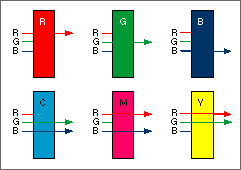 Remember: filters will pass their own color of light, and they will absorb their complementary color.
Remember: filters will pass their own color of light, and they will absorb their complementary color.
Photographic films and papers use secondary color filters to reproduce all the colors of the visible spectrum. By combining the correct proportions of cyan, magenta and yellow filters, any color can be formed. This is referred to as subtractive color photography. As seen in the figure above, cyan controls or subtracts the red light, while magenta subtracts the green and yellow controls the blue light.
Color Negative Films
Color photographic films and papers are generally made up of three separate light sensitive layers, each sensitive to one of the primary colors of light; red, green or blue. Negative films are typically constructed with a transparent base, on which three layers of light sensitive emulsion are coated. (Again, each of the layers is sensitive to a primary color.) The layer next to the base generally is sensitive to red light, the middle to green and the top to blue light. When the red sensitive layer is exposed to red light, a latent or potential image is formed in that layer. The same is true if the film is exposed to green light or blue light, a latent image or dye potential will be formed in each corresponding layer.
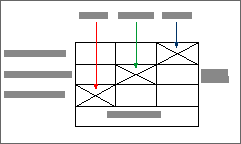
Image or dye potential infers that it is now possible for a dye image to be formed in that layer. Earlier it was stated that the colors present in the film are made up of transparent color filters. The colored filters that are in the film are actually transparent dyes that form in the emulsion after the exposed film is chemically processed.
If the red sensitive layer is exposed to light and then chemically processed, a cyan dye or filter will be formed in that layer. Likewise, when the green sensitive layer is exposed and processed, a magenta dye is formed. The blue layer, if exposed, will process up to a yellow dye.
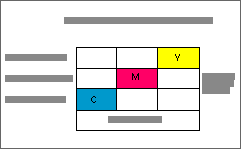
Colors other than the primary colors, expose more than one layer. A yellow object, for example, will expose the red and green layers. Remember, that a yellow object reflects yellow light which is made up of red and green light.
Below are several examples of different colored objects, each reflects a different combination of primary color light to the film. After processing, there are also different combinations of dye layers formed in the film for each.
A color negative derives its "negative" name from the fact that both the densities and the color in the negative are the opposite of those in the original scene. That is, dark areas in the scene are represented by light areas in the negative, as are light areas in the scene represented by dark areas in the negative. And, each of the colors in the scene is represented by the opposite or complimentary color in the negative.
As depicted in the previous diagram, a red object captured on a negative color film, after chemical processing, would be represented by a cyan dye filter. Simply put, if we took a photograph of a red ball, that red ball would look cyan in the negative. A green ball would look magenta and a blue ball would look yellow.
A secondary colored ball, such as a yellow ball. would be represented by two color dyes in the negative. In this case; magenta and cyan. The two dyes when viewed together will look blue, the opposite of yellow. How is this possible? It is quite easy to explain if we remember the properties of transparent filters; they pass their own color and absorb their complement.
When white light is passed through these two filters, the only light that is allowed to pass through is blue light. A magenta filter allows the red and blue portions of the light to pass but absorbs the green. A cyan filter allows the green and blue portions of the light to pass but absorbs the red. By combining the two filters together, a new filter is formed which passes blue light and blocks red and green, thus the object represented looks blue in the negative.

The other secondary colors would be represented the same way. A magenta colored object would be represented by cyan and yellow dye layers in the film, and when combined, will pass only green light. A cyan colored object will be represented by a magenta and yellow dye layer passing only red light. Thus a magenta colored object, in the original scene, will look green in the negative and a cyan object will look red.
A white object in the scene will be represented by a cyan, magenta and yellow filter dye layers in the film. When viewed, this area will look black. The cyan dye will absorb the red light, the magenta dye the green, and the yellow layer will absorb the blue light leaving nothing but the absence of light and color, which is black.
Color Theory Quiz
1) Which of the following are the primary colors of light?
- Red, Green and Blue
- Cyan, Magenta and Yellow
- Red, Blue and Yellow
- Green, Orange and Purple
2) Which of the following are the secondary colors of light?
- Red, Green and Blue
- Cyan, Magenta and Yellow
- Red, Blue and Yellow
- Green, Orange and Purple
3) When combined, complementary colors of light form _____________.
- the emulsion layers
- all the colors of the spectrum
- a secondary color
- white light
4) The complement of yellow is ____________.
- red
- green
- blue
- cyan
5) Transparent filters will ____________ their own color of light.
- block
- pass
- absorb
- reflect
6) A magenta filter will allow ____________ light to pass.
- green and blue
- red and blue
- red and green
7) A _____________ colored dye will be formed in the blue sensitive layer of a processed negative.
- cyan
- magenta
- yellow
- orange
8) If a cyan ball was photographed, _____________ dye/dyes would form in the processed negative.
- cyan
- magenta and yellow
- red
- green and blue
answers:
1 = a
2 = b
3 = d
4 = c
5 = b
6 = b
7 = c
8 = b
Go To | Training Guide 2 |
Training Guide 3 |
Training Guide 4 |
Training Guide 5 |
Training Guide 6 |


Copyright 1996 Imation. All rights reserved.













|





